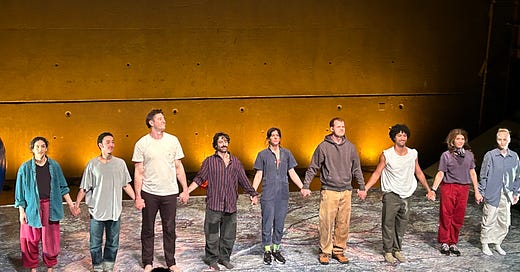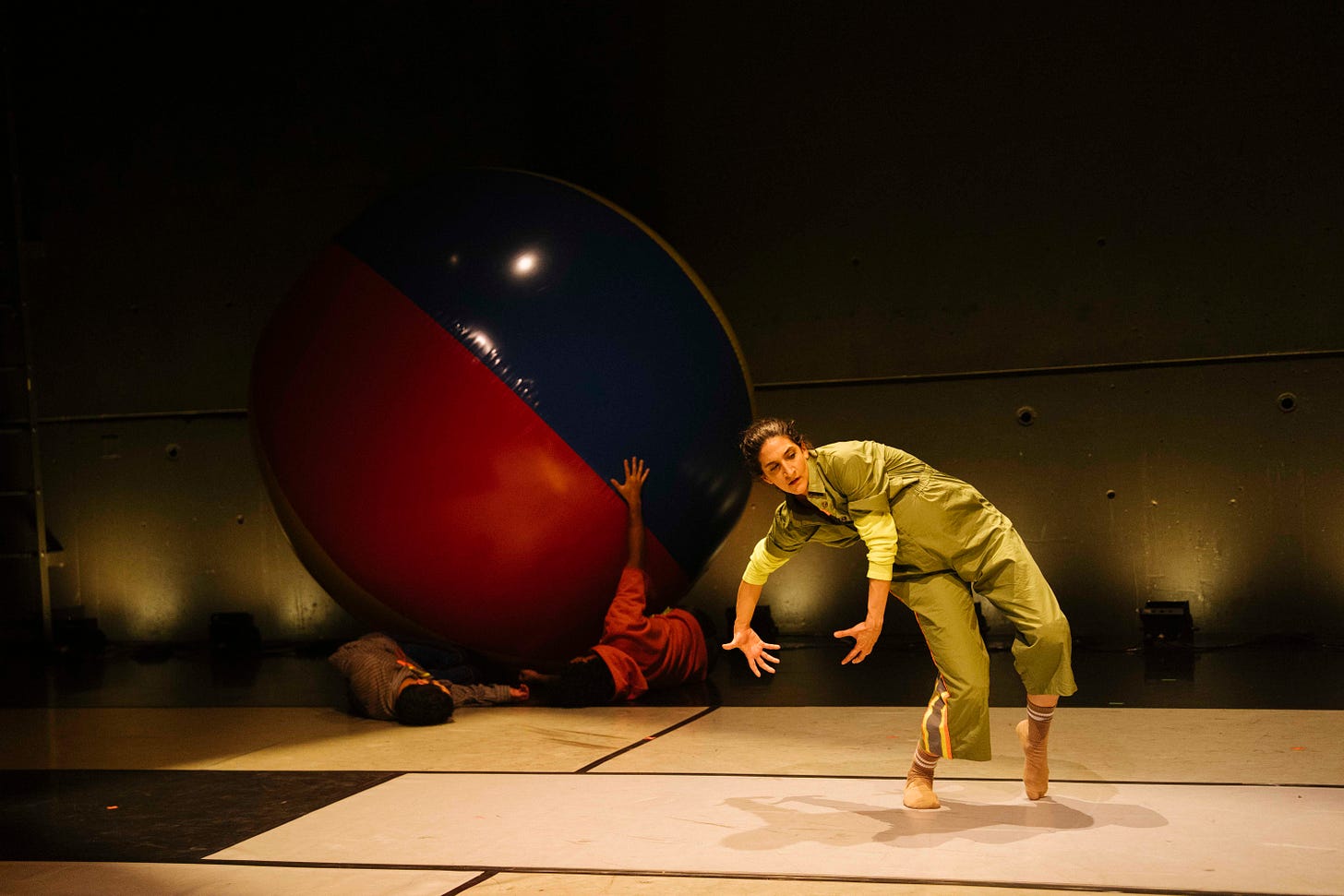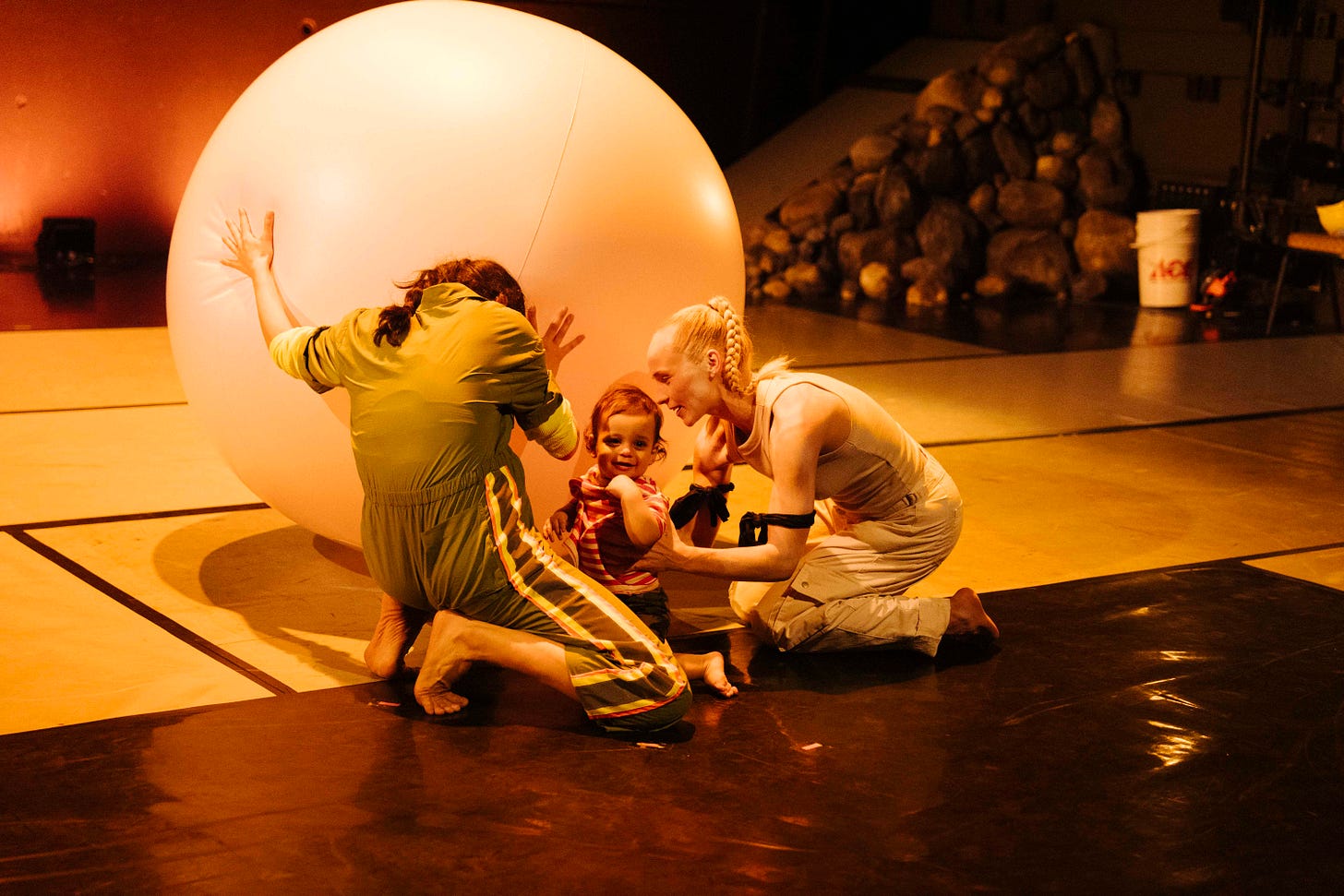The cast of Celia Rowlson-Hall’s “Sissy”
Middle age is a tricky time, in which early promise is either realized or not and life’s weighty problems become insistently present. Parents age, children require attention, finances must be tended to. Time for creative pursuits is limited, and often comes in disconnected spurts, if at all. Taking the time to complete something, as Celia Rowlson-Hall depicts in her new work Sissy, becomes something of a Sisyphean task. (Sissy is a Sisyphus legend for our time.)
The show, performed April 24-26 at the Baryshnikov Arts Center, is equal parts dance, portrait of the author, and surrealist theater. A narrator, or “The Director,” played by Zoe Winters, stands in for Rowlson-Hall. It is Winters who lays out the show’s mundane but universal themes: parental illnesses, child-rearing, the inability to focus. She speaks to the audience directly, tying together Sissy’s disparate sections, almost apologizing for its flaws. Harried, barely keeping it together, her character must submit to constant interruption: a construction worker who warns that the building in which she finds herself is about to be demolished, telephone calls from the hospital, child-care.
Ida Saki and the giant beach-ball. Photo by Atsushi Nishijima.
Disruption and distraction become the work’s structural principles, as Sissy pinballs from one scene to the next. A slow, dreamlike solo for a pregnant Ida Saki gives way to the efforts of a giant (Jacob Warren), who pushes an enormous beach-ball across the stage, like a hero in an Art Deco frieze. Two lithe male dancers (Jesse Kovarsky and Nando Morlan) move through the space with enviable liquidity, like sprites, disconnected from the gravity that surrounds them. The full cast engages in a rousing flashlight dance, as at a rave.
Passages of movement alternate with absurdist scenes, as when the elusive Aliza Russell is carried on, wearing mannequin arms that soon fall off, becoming a living replica of the Venus de Milo. Saki’s character, distressed, tries to cover her with her own body. A one-year-old toddler (Saki’s son) helps to push another giant ball toward the rear of the stage. He, too, keeps getting distracted, ever so cutely.
The show’s star turn is the appearance of the actress Marisa Tomei, impersonating a paleobotanist who, in yet another surrealist aside, has discovered the preserved remains of an ancient, petrified forest somewhere offstage. Her character is funny and all-over-the-place, as so many Tomei characters are. And Tomei can move; at one point she slides, effortlessly, into a split. How many Oscar-winning actresses can do that?
About that petrified forest: It seems to be a metaphor for time and our own smallness. Who are we in the context of the long arc of the planet’s existence? Birth, life, death are all but a blip.
The point is true enough. Sissy has humanity and humor, but too often feels like a grab bag of ideas and impressions, incompletely realized. Perhaps the most compelling thing about it is its honesty: this is the best that could be done under the circumstances. Its best moment, besides the flashlight dance, comes near the end. The construction worker, played by Lucas Hedges, remembers how he memorized a dance from Riverdance as a small child. (For which he was called a “sissy” by his father.) Asked whether he still remembers it, he breaks into a rollicking Irish dance, full of jumps and kicks and quick footwork. Everyone joins in. No-one in the cast is an actual Irish dancer, and their dance is a far cry from the real thing. But the fun of just letting loose is something we can all relate to. It performs the function dance so often does: release us, momentarily, from the drudgery of life.
Ida Saki, her son, and Aliza Russell. Photo by Atsushi Nishijima








An interesting take on the ordinary that seems to not rise above itself? Cheers, Jean
You were more generous than I would have been. But pointed out details that are worth stopping over.
I’m looking forward to the Stanley Williams discussion—where I’ll feel more at home.